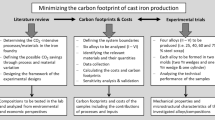Abstract
A bibliometric study based on worldwide scientific and technical publications on refractory materials used in iron and steelmaking processes during 1980–87, has been carried out. Six bibliographic databases were searched and from them 2464 references were retrieved. The highest percentage of published documents were journal articles (60%), followed by patents (33%). The core journals areOgneupory (USSR) andTaikabutsu (Japan). The USSR was by far the most productive country, both in number of published papers and in number of journal titles devoted to the subject. In The Soviet Union research work is mainly carried out in universities and institutes of the Academy of Sciences. On the other hand, Japan is the most productive country in patent registered, and research work is carried out there either in private refractory companies or in steelmaking enterprises. The trend in worldwide research points towards shaped refractories, particularly based in high alumina, magnesia, zircon carbides and mixtures containing oxides and carbon, which are largely used in converters, transport ladles and continuous casting processes.
Similar content being viewed by others
References
Y. Naruse, Future trends and development of refractories industry in Japan,Proc. II International Conference on Refractories, Tokio, November 1987. p.3–59. The Technical Association of Refractories Japan, (Ed.).
B.M. Rimmer, Abstracts journals: a survey of patent coverage,Journal of Documentation, 44 No. 2, (1988) 159–165.
J.T. Maynard, Chemical Abstracts as a patent reference tool,Journal of Chemical Information and Computer Science 17 No. 3 (1977) 136–143.
S.C. Bradford,Documentation, Crosby Lockwood and Son, Ltd. London. England, 1948.
B.C. Brookes, Theory of Bradrod law,Journal of Documentation, 33 No. 3, (1977) 180–209.
B.C. Brookes, The derivation and application of the Bradford-Zipf distribution,Journal of Documentation, 24 No. 4. (1968) 247–265.
P.J. Pollick, Patents and Chemical Abstracts Service,Science and Technology Libraries, 2 No. 2, (1981) 3–22.
P.J. Pollick, Selection of patents for the Chemical Abstracts Service data base,Journal of Chemical Information and Computer Sciences, 23 (1983) 160–165.
F. Narin, D. Olivastro, Technology indicators based on patents and patent citations, Chapter 15;Handbook of Quantitative Studies on Science and Technology.A.F.J. Vann Raam (Ed.) Elsevier Sc. Pub. 1988.
M. Rimmer, A. Green, Patents information. A review of recent changes,Journal of Documentation, 41 No. 4, (1985) 247–266.
H. Grupp, The concept of entropy in scientometrics and innovation research,Scientometrics, 18 (1990) 219–239.
A. Schubert, S. Zsindely, T. Braun, Scientometric analysis of attendance at international scientific meetings,Scientometrics, 5 (1983), 177–187.
Refractory Materials Recommendations 1978, European Federation of Manufacturers of Refractory Products. Zurich, Switzerland, 1978.
Vocabulary for the Refractory Materials in Iron and Steelmaking, ISO (836/68). Paris, 1968.
Documentation Europeene de la Ceramique. Ed. Societe Francaise de la Ceramique. Paris. 1963.
G. Routschka, A. Madjic, Refractories for steelmaking converters,Keramische Zeitschrift, 36 No. 9, (1984) 460–470.
C. Semler, Needs and concerns of the US refractories industry,Ceramic Bulletin, 67 No. 7, (1988) 1148–1153.
T. Power, Restructural and rationalized the world's major refractory producers,Industrial Minerals 9 (1986) 79–85.
H. Logih, Trends in the European refractories,Ceramic Bulletin, 67 No. 7, (1988) 1161–1162.
E.S. Wright, Trends in the iron and steel industry of North American and their effect on the refractories manufacturers,Proc. UNITECR 89,L.J. Trostel, (Jr), (Ed.) American Ceramic Society, Ohio, USA. 1989, pp. 3–19.
Y. Sagalevich, Main trends in developing the refractories industry in the USSR,Proc. UNITECR 89.,L.J. Trostel, (Jr), (Ed.), American Ceramic Society, Ohio, USA. 1989, pp. 87–101.
Author information
Authors and Affiliations
Rights and permissions
About this article
Cite this article
Sancho, R., Pastor, A. & Criado, E. Bibliometric approach to research performance in the field of refractory materials used in iron and steelmaking processes. Scientometrics 24, 115–136 (1992). https://doi.org/10.1007/BF02026476
Received:
Issue Date:
DOI: https://doi.org/10.1007/BF02026476




